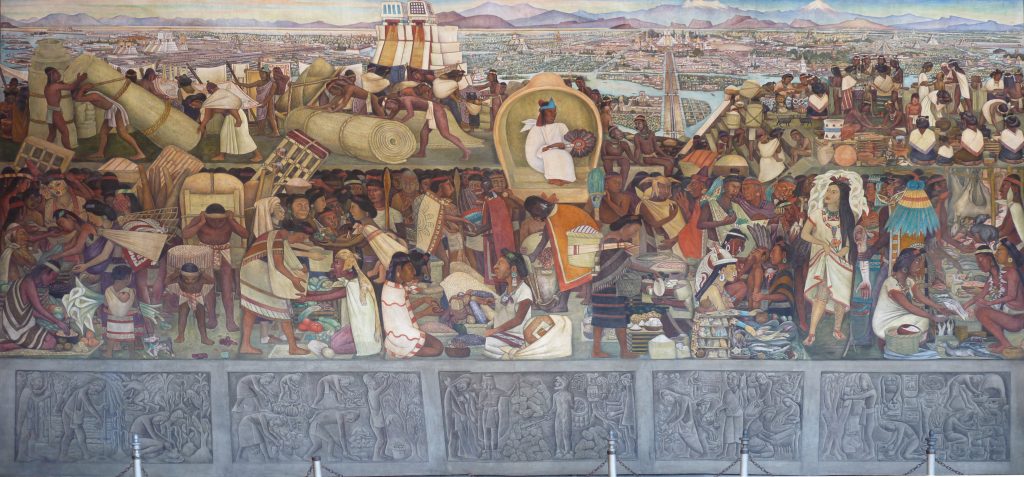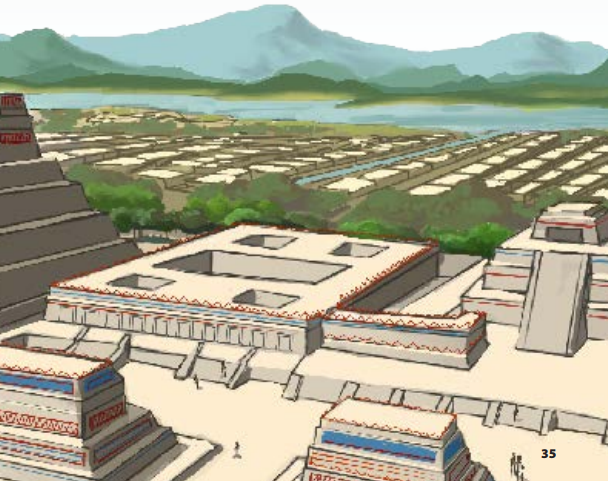

The Great City of Tenochtitlan, by Diego Rivera, 1945 / National Palace of Mexico, Wikimedia Commons
The Aztec empire existed more than 500 years after the Maya abandoned their great inland city-states.

Curated/Reviewed by Matthew A. McIntosh
Public Historian
Brewminate
Introduction
Did you know that the modern capital of Mexico, Mexico City, was built on top of another city? If you visit Mexico City today, you can see archaeologists at work.They are busy uncovering the ancient city of Tenochtitlán.
Tenochtitlán was the capital of the Aztec Empire in the 1300s and 1400s. This empire existed more than 500 years after the Maya abandoned their great inland city-states. The ancestors of the people now known as the Aztec migrated from the north. By 1325 CE, they had settled in the Valley of Mexico.
Other people had lived in Mexico’s fertile valley for thousands of years before the Aztec arrived. Many groups were competing for space. The Aztec had several temporary homes, all of which they were eventually forced to leave. The land the Aztec finally claimed may seem an unlikely choice—two swampy islands in the middle of Lake Texcoco.
Aztec Beginnings in Lake Texoco
On the lake shore, the Aztec built mud huts and lived on food from the lake: frogs, fish, and algae. They hunted deer, rabbits, coyotes, armadillos, and snakes. They raised bees, turkeys, and ducks. They gathered grasshoppers and worms for food.
The Aztec adapted to their swampy environment by creating habitable land from the lake bottom. They built gardens, called chinampas, in the middle of Lake Texcoco. They built bridges over the marshes and grew a variety of crops on the mainland as well. They cultivated corn, beans, squash, tomatoes,amaranth, and chilies. Members of the ruling class grew fruit trees in their small personal gardens. Crops grew throughout the year in Mesoamerica’s tropical climate. As food supplies expanded, Tenochtitlán grew.
Chinampas: Gardens Built from a Lakebed

The Aztec perfected a technique for building gardens in Lake Texcoco. First,they scooped up mud from the bottom of the shallow lake. Then,they piled layers of mud and aquatic plants on top of one another.They used reed posts to anchor these rectangular gardens to the lake floor. They planted willow trees along the borders to help hold the artificially filled lake shore in place. A series of canals crossed the chinampas, providing a year-round source of water for crops. Fish and other aquatic life lived in the canals and were another source of food.
Tenochtitlán: A Well-Planned City

Tenochtitlán was laid out on a grid. Its streets and canals formed a pattern of squares. Its religious and ceremonial center was located at the heart of the city. This Sacred Precinct, or pyramid-temple complex, was much larger than those at the Maya centers. Stone walls carved with serpents surrounded the precinct. The Great Temple, or Templo Mayor, dominated the space inside the walls. On top of Templo Mayor, the Aztec built shrine sto honor their two most important gods. One shrine was dedicated to Huitzilopochtli, the sun god. The other honored Tlaloc, the rain god.
Social class determined where people lived, how they dressed, and how they earned a living. Aztec priests lived in palaces within the Sacred Precinct.Just outside the Sacred Precinct, the emperor and members of the noble class built carved stone palaces and beautiful gardens. Beyond its city center, Tenochtitlán was divided into four sections, or quadrants. Each quadrant was divided into 20 calpullin, or districts. Each one, by itself called a calpulli, had its own farm, marketplace, and school.

Commoners, including merchants, artisans, and farmers, lived together in the capullin. They built their houses of sun-dried clay bricks called adobe.These one-story houses often had peaked thatch roofs. Others had flat earthen roofs used for planting gardens. Many people also built domed mud huts outside their homes. These huts were used as sweat baths. The Aztec lit fires outside the huts to warm the walls. They entered the sweat baths once the inside walls became hot. They threw water against the heated walls, producing steam. The effect was similar to modern-day steam baths and saunas.
Causeways, Aqueducts, and Marketplaces
Lake Texcoco contained salt water. Providing fresh water for the population of Tenochtitlán was a challenge. The Aztec used sand, dirt, rocks, and wooden stakes to build three wide causeways. Each causeway was about two and a half miles long.These wide, raised roads connected the city to natural springs on the mainland. Each causeway supported an aqueduct, a structure built to carry water. The aqueduct consisted of two clay pipes.One transported fresh water from the springs into Tenochtitlán for drinking and bathing. The second pipe was a spare, used only when the first pipe needed cleaning.
Bustling marketplaces filled Tenochtitlán and other cities.At the grand market in nearby Tlatelolco, thousands of people traded daily for goods such as clothing, food, and pottery.Merchants brought goods to exchange from all over central Mexico and even beyond.
Gods, Goddesses, and Sacrifices

Like the Maya, the Aztec believed in multiple gods and goddesses.They believed in gods of nature, gods of health, and gods of war. The Aztec believed that the sun god, Huitzilopochtli, could not make his daily journey from east to west without nourishment. They believed that the sun would not rise and the world would end if they did not feed Huitzilopochtli.
The Aztec believed that the gods,humans, and nature worked together. The Aztec lived in a region surrounded by volcanic mountains. It was an area where earthquakes were likely to occur.They believed that the gods controlled these forces of nature. If the people angered the gods, the gods might rattle the earth or release hot lava from the mountains. So, like the Maya, the Aztec made sacrifices to the gods. Many human sacrifices took place at the Templo Mayor inside the Sacred Precinct.
At the base of the temple steps, the Aztec built a rectangular ball court.The object of the ball game, called ullamaliztli, was to pass a rubber ball through a stone ring. Doesn’t that sound a lot like the Maya game of pok-a-tok? Like pok-a-tok, the Aztec ball game was sometimes played as part of religious rituals. Sometimes players were sacrificed at the end of the game. Not far from the court at Tenochtitlán, archaeologists unearthed evidence of these sacrifices.
Everyday Life in the Aztec Empire

The Aztec valued education.Boys went to different schools depending upon their social status.Noble boys were taught by priests in the temples. They learned to read and write and trained to be future leaders. In addition, noble boys learned about religion, medicine,law, and astronomy. Boys from lower social ranks attended schools where they learned a trade, such as building roads or repairing temples.From an early age, all boys trained for battle. Girls were educated separately. They learned the arts of cooking, sewing, and weaving.

Women and girls used fibers from both cotton and maguey cactus plants to weave beautiful cloth. Commoners and nobles alike wore bright and colorful fabrics dyed with natural plant dyes.Clothing styles varied throughout the Aztec Empire, but all clothing was loose and simple. Men and boys wore loincloths and draped themselves in triangular cloaks.Women and girls wore long skirts and sleeveless blouses. Noble men and women preferred clothes made of cotton and added gold, feathers,and fur. Necklaces, earrings, and bracelets made of precious gems decorated their bodies.
From Early American Civilizations: Maya, Aztec, and Inca, originally published by the Core Knowledge Foundation under the terms of a Creative Commons Attribution-NonCommercial-ShareAlike 4.0 International license.






